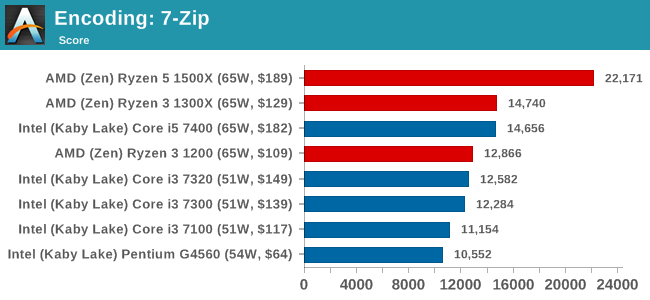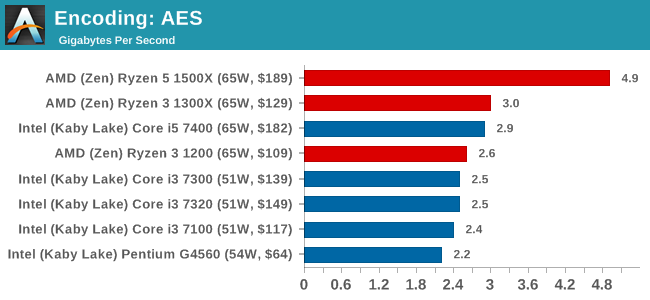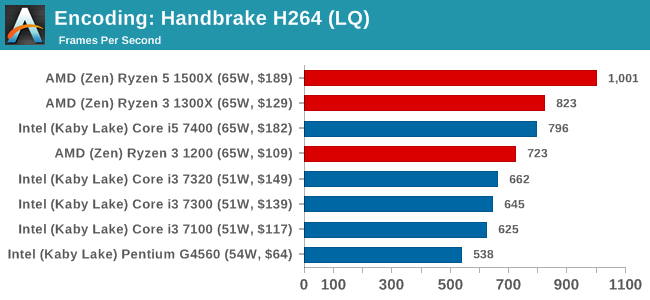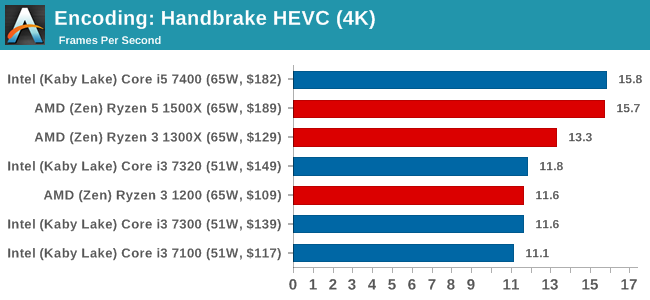The AMD Ryzen 3 1300X and Ryzen 3 1200 CPU Review: Zen on a Budget
by Ian Cutress on July 27, 2017 9:30 AM EST- Posted in
- CPUs
- AMD
- Zen
- Ryzen
- Ryzen 3
- Ryzen 3 1300X
- Ryzen 3 1200
Benchmarking Performance: CPU Encoding Tests
One of the interesting elements on modern processors is encoding performance. This includes encryption/decryption, as well as video transcoding from one video format to another. In the encrypt/decrypt scenario, this remains pertinent to on-the-fly encryption of sensitive data - a process by which more modern devices are leaning to for software security. Video transcoding as a tool to adjust the quality, file size and resolution of a video file has boomed in recent years, such as providing the optimum video for devices before consumption, or for game streamers who are wanting to upload the output from their video camera in real-time. As we move into live 3D video, this task will only get more strenuous, and it turns out that the performance of certain algorithms is a function of the input/output of the content.
All of our benchmark results can also be found in our benchmark engine, Bench.
7-Zip 9.2: link
One of the freeware compression tools that offers good scaling performance between processors is 7-Zip. It runs under an open-source licence, is fast, and easy to use tool for power users. We run the benchmark mode via the command line for four loops and take the output score.

WinRAR 5.40: link
For the 2017 test suite, we move to the latest version of WinRAR in our compression test. WinRAR in some quarters is more user-friendly that 7-Zip, hence its inclusion. Rather than use a benchmark mode as we did with 7-Zip, here we take a set of files representative of a generic stack (33 video files in 1.37 GB, 2834 smaller website files in 370 folders in 150 MB) of compressible and incompressible formats. The results shown are the time taken to encode the file. Due to DRAM caching, we run the test 10 times and take the average of the last five runs when the benchmark is in a steady state.

AES Encoding
Algorithms using AES coding have spread far and wide as a ubiquitous tool for encryption. Again, this is another CPU limited test, and modern CPUs have special AES pathways to accelerate their performance. We often see scaling in both frequency and cores with this benchmark. We use the latest version of TrueCrypt and run its benchmark mode over 1GB of in-DRAM data. Results shown are the GB/s average of encryption and decryption.

HandBrake v1.0.2 H264 and HEVC: link
As mentioned above, video transcoding (both encode and decode) is a hot topic in performance metrics as more and more content is being created. First consideration is the standard in which the video is encoded, which can be lossless or lossy, trade performance for file-size, trade quality for file-size, or all of the above can increase encoding rates to help accelerate decoding rates. Alongside Google's favorite codec, VP9, there are two others that are taking hold: H264, the older codec, is practically everywhere and is designed to be optimized for 1080p video, and HEVC (or H265) that is aimed to provide the same quality as H264 but at a lower file-size (or better quality for the same size). HEVC is important as 4K is streamed over the air, meaning less bits need to be transferred for the same quality content.
Handbrake is a favored tool for transcoding, and so our test regime takes care of three areas.
Low Quality/Resolution H264: He we transcode a 640x266 H264 rip of a 2 hour film, and change the encoding from Main profile to High profile, using the very-fast preset.

High Quality/Resolution H264: A similar test, but this time we take a ten-minute double 4K (3840x4320) file running at 60 Hz and transcode from Main to High, using the very-fast preset.

HEVC Test: Using the same video in HQ, we change the resolution and codec of the original video from 4K60 in H264 into 4K60 HEVC.











140 Comments
View All Comments
uibo - Thursday, July 27, 2017 - link
I thought you guys hated misleading scales on graphs.Looking at the performance per dollar graphs, I think the lowest point vertically should be -100%
lefenzy - Thursday, July 27, 2017 - link
That's silly. 0% is the zero on that graph, not some arbitrary -100%akrobet - Thursday, July 27, 2017 - link
Keep in mind that Intel is pulling the G4560 from the market, because it's "too good" for its price.MajGenRelativity - Thursday, July 27, 2017 - link
Source?MrCommunistGen - Thursday, July 27, 2017 - link
Not counting it as a "source" but I saw this pop up at wccftech. I didn't spend any time looking, but I haven't stumbled upon any corroboration on other sites in my tech reading.MajGenRelativity - Thursday, July 27, 2017 - link
I just found the article on wccftech. It actually said that Intel is NOT killing off the G4560T1beriu - Thursday, July 27, 2017 - link
wccftech....
....
BWHAHAHAHAHAHAH
GreenMeters - Thursday, July 27, 2017 - link
SHED does not exist. Ryzen 7 maps to the standard i7 market that has never been called HEDT. Threadripper is HEDT. The fact that it puts Intel's HEDT to shame doesn't mean it's a new segment. It means Intel better get with the program.Ian Cutress - Thursday, July 27, 2017 - link
Ryzen 7 was mapped against Intel's Broadwell-E HEDT platform at launch for core count, performance, and aggressive pricing. Threadripper is a stage above that, and isn't even called HEDT internally at AMD. Then we have the HCC core count silicon coming from Intel. SHED exists.DrKlahn - Thursday, July 27, 2017 - link
Ok I'm seriously beginning to wonder about the objectivity here. So your conclude this:"First is that the Ryzen 3 1200 does not look like an attractive option. It performs +2-3% of the Pentium but is $30 more expensive, and the Core i3-7100 beats it by 8% for only a sub-$10 cost."
But aren't mentioning that the Pentiums are locked parts and the 1200 isn't? Your competing sites do have overclocking data and the Pentiums are hopelessly outclassed. Granted not everyone overclocks, but on an enthusiast site that at least warrants a mention. Not everyone will read your followup(s) and that conclusion does not tell the full story. I know if I was building a machine a 1200 4 core that overclocks to 3.8-4GHz is well worth the $30.